Physical Properties and pH Environment of Foam Dressing Containing Eclipta prostrata Leaf Extract and Gelatin
Abstract
1. Introduction
2. Results
2.1. Thickness Test
2.2. Fourier-Transform Infrared Spectroscopy (FTIR)
2.3. Morphological Properties
2.4. Absorption Properties
2.5. Dehydration Properties
2.6. pH Measurement
2.7. Dispersion Characteristics
3. Discussion
4. Materials and Methods
4.1. Materials
4.2. Preparation of Foam Dressing Containing E. prostrata Extract and Gelatin
4.3. Thickness Test
4.4. Fourier Transform Infrared Spectroscopy (FTIR)
4.5. Morphological Properties
4.6. Absorption Properties
4.7. Dehydration Properties
4.8. pH Measurement
4.9. Dispersion Characteristics
4.10. Statistical Analysis
5. Conclusions
Author Contributions
Funding
Institutional Review Board Statement
Informed Consent Statement
Data Availability Statement
Acknowledgments
Conflicts of Interest
References
- Kepekçi, R.A.; Yener İlçe, B.; Demir Kanmazalp, S. Plant-derived biomaterials for wound healing. In Studies in Natural Products Chemistry; Elsevier: Amsterdam, The Netherlands, 2021; pp. 227–264. [Google Scholar]
- Martin, C.; Low, W.L.; Amin, M.C.I.M.; Radecka, I.; Raj, P.; Kenward, K. Current trends in the development of wound dressings, bio-materials and devices. Pharm. Pat. Anal. 2013, 2, 341–359. [Google Scholar] [CrossRef] [PubMed]
- Yazarlu, O.; Iranshahi, M.; Kashani, H.R.; Reshadat, S.; Habtemariam, S.; Iranshahy, M.; Hasanpour, M. Perspective on the application of medicinal plants and natural products in wound healing: A mechanistic review. Pharm. Res. 2021, 174, 105841. [Google Scholar] [CrossRef] [PubMed]
- Timalsina, D.; Devkota, H.P. Eclipta prostrata (L.) L. (Asteraceae): Ethnomedicinal uses, chemical constituents, and biological activities. Biomolecules 2021, 11, 1738. [Google Scholar] [CrossRef] [PubMed]
- Feng, L.; Zhai, Y.Y.; Xu, J.; Yao, W.F.; Cao, Y.D.; Cheng, F.F.; Bao, B.H.; Zhang, L. A review on traditional uses, phytochemistry and pharmacology of Eclipta prostrata (L.) L. J. Ethnopharmacol. 2019, 245, 112109. [Google Scholar] [CrossRef]
- Gurrapu, S.; Mamidala, E.; Mamidala, E.; Mamidala, E. In vitro Antibacterial Activity of Alkaloids Isolated from Leaves of Eclipta alba Against Human Pathogenic Bacteria. Pharmacogn. J. 2017, 9, 573–577. [Google Scholar] [CrossRef]
- Nahid, A.; Neelabh, C.; Navneet, K.; Kumar Navneet, C. Evaluation of antioxidant and antimicrobial potentials of Eclipta prostrata collected from the Nepal region. Pharma Innov. J. 2017, 6, 4–7. [Google Scholar]
- Singh, L.; Antil, R.; Kumar, D.; Dahiya, P. Phytochemical analysis and In-vitro assays for antimicrobial and antioxidant activity of Bhringraj herb Eclipta prostrata (L.). J. Pharm. Phytochem. 2019, 8, 4527–4533. [Google Scholar]
- Arunachalam, G.; Subramanian, N.; Pazhani, G.P.; Ravichandran, V. Anti-inflammatory activity of methanolic extract of Eclipta prostrata L. (Astearaceae). Afr. J. Pharm. Pharmacol. 2009, 3, 97–100. [Google Scholar]
- Kang, Y.M.; Kim, H.M.; Lee, H.; Lee, D.S.; An, H.J. Anti-inflammatory effects of Eclipta prostrata Linné on house dust mite-induced atopic dermatitis in vivo and in vitro. J. Ethnopharmacol. 2022, 292, 115233. [Google Scholar] [CrossRef]
- Raoul, A.; CyrJonas, M.; MatokoChristevyRommelle, S.; ItouDeGardeRomaric, E.; Martin, D.; AngeAntoine, A. Antidiabetic and Wounds Healing Activities of Eclipta prostrata (Asteraceae) Leaves. Int. J. Adv. Res. 2018, 6, 393–398. [Google Scholar] [CrossRef]
- Babu, I.S.; Bhramaramba, R.; Tegjaswini, S.S.N. Formulation and Evaluation of Herbal Gel containing Eclipta alba Linn., leaves extract. Int. J. Adv. Pharm. Biol. Chem. 2015, 4, 496–500. [Google Scholar]
- Edwards, H.; Gibb, M.; Finlayson, K.; Jensen, R. Wound Dressing Guide; Institute of Health and Biomedical Innovation: Kelvin Grove, Australia, 2013; pp. 1–49. [Google Scholar]
- Dabiri, G.; Damstetter, E.; Phillips, T. Choosing a Wound Dressing Based on Common Wound Characteristics. Adv. Wound Care 2016, 5, 32–41. [Google Scholar] [CrossRef] [PubMed]
- Vivcharenko, V.; Przekora, A. Modifications of wound dressings with bioactive agents to achieve improved pro-healing properties. Appl. Sci. 2021, 11, 4114. [Google Scholar] [CrossRef]
- Broussard, K.C.; Powers, J.G. Wound dressings: Selecting the most appropriate type. Am. J. Clin. Dermatol. 2013, 14, 449–459. [Google Scholar] [CrossRef]
- Cutting, K.F.; White, R.J. Maceration of the skin and wound bed. 1: Its nature and causes. J. Wound Care 2002, 11, 275–278. [Google Scholar] [CrossRef] [PubMed]
- Rezvani Ghomi, E.; Khalili, S.; Nouri Khorasani, S.; Esmaeely Neisiany, R.; Ramakrishna, S. Wound dressings: Current advances and future directions. J. Appl. Polym. Sci. 2019, 136, 47738. [Google Scholar] [CrossRef]
- Gardner, S. Managing high exudate wounds. Wound Essent. 2012, 7, 1–3. [Google Scholar]
- Hasatsri, S.; Pitiratanaworanat, A.; Swangwit, S.; Boochakul, C.; Tragoonsupachai, C. Comparison of the Morphological and Physical Properties of Different Absorbent Wound Dressings. Dermatol. Res. Pract. 2018, 2018, 9367034. [Google Scholar] [CrossRef]
- Dhivya, S.; Padma, V.V.; Santhini, E. Wound dressings—A review. BioMedicine 2015, 5, 24–28. [Google Scholar] [CrossRef]
- Butcher, M. Moist wound healing, exudate and management of the wound bed. J. Wound Care 2013, 19 (Suppl. S5), 10–13. [Google Scholar] [CrossRef]
- Nuutila, K.; Eriksson, E. Moist Wound Healing with Commonly Available Dressings. Adv. Wound Care 2021, 10, 685–698. [Google Scholar] [CrossRef]
- Sharman, D. Moist Wound Healing: A Review of Evidence, Application and Outcome. Diabet. Foot. 2003, 6, 112–120. [Google Scholar]
- Sim, P.; Strudwick, X.L.; Song, Y.M.; Cowin, A.J.; Garg, S. Influence of Acidic pH on Wound Healing In Vivo: A Novel Perspective for Wound Treatment. Int. J. Mol. Sci. 2022, 23, 13655. [Google Scholar] [CrossRef]
- Aly, R.; Shirley, C.; Cunico, B.; Maibach, H.I. Effect of prolonged occlusion on the microbial flora, pH, carbon dioxide and transep-idermal water loss on human skin. J. Investig. Dermatol. 1978, 71, 378–381. [Google Scholar] [CrossRef]
- Toker-Bayraktar, M.; Erenay, B.; Altun, B.; Odabaş, S.; Garipcan, B. Plant-derived biomaterials and scaffolds. Cellulose 2023, 30, 2731–2751. [Google Scholar] [CrossRef]
- Karageorgiou, V.; Kaplan, D. Porosity of 3D biomaterial scaffolds and osteogenesis. Biomaterials 2005, 26, 5474–5491. [Google Scholar] [CrossRef] [PubMed]
- Guo, S.; DiPietro, L.A. Factors affecting wound healing. J. Dent. Res. 2010, 89, 219–229. [Google Scholar] [CrossRef] [PubMed]
- Evren Okur, M.; Karantas, I.D.; Enyi, S.; Üstünda, N.; Siafaka, P.I. Recent trends on wound management: New therapeutic choices based on polymeric carriers. Asian J. Pharm. Sci. 2020, 15, 661–684. [Google Scholar] [CrossRef]
- Sultana, N.; Hassan, M.I.; Ridzuan, N.; Ibrahim, Z.; Soon, C.F. Fabrication of gelatin scaffolds using thermally induced phase separation technique. Int. J. Eng. Trans. B Appl. 2018, 31, 1302–1307. [Google Scholar]
- Annabi, N.; Nichol, J.W.; Zhong, X.; Ji, C.; Koshy, S.; Khademhosseini, A.; Dehghani, F. Controlling the Porosity and Microarchitecture of Hydrogels for Tissue Engineering. Tissue Eng. 2010, 16, 371–383. [Google Scholar] [CrossRef]
- Ndlovu, S.P.; Ngece, K.; Alven, S.; Aderibigbe, B.A. Gelatin-based hybrid scaffolds: Promising wound dressings. Polymers 2021, 13, 2959. [Google Scholar] [CrossRef] [PubMed]
- Naomi, R.; Bahari, H.; Ridzuan, P.M.; Othman, F. Natural-based biomaterial for skin wound healing (Gelatin vs. collagen): Expert review. Polymers 2021, 13, 2319. [Google Scholar] [CrossRef] [PubMed]
- Cebi, N.; Durak, M.Z.; Toker, O.S.; Sagdic, O.; Arici, M. An evaluation of Fourier transforms infrared spectroscopy method for the classification and discrimination of bovine, porcine and fish gelatins. Food Chem. 2016, 190, 1109–1115. [Google Scholar] [CrossRef] [PubMed]
- Mahmoud, A.A.; Osman, O.; Eid, K.; Ashkar, E.A.; Okasha, A.; Atta, D.; Eid, M.; Aziz, Z.A.; Fakhry, A. FTIR Spectroscopy of Natural Bio-Polymers Blends. Middle East. J. Appl. Sci. 2014, 4, 816–824. [Google Scholar]
- Thomas, M.; Hamdan, M.; Hailes, S.; Walker, M. An investigation into the conformability of wound dressings. Wounds UK 2011, 7, 14–24. [Google Scholar]
- Said, N.S.; Sarbon, N.M. Physical and Mechanical Characteristics of Gelatin-Based Films as a Potential Food Packaging Material: A Review. Membranes 2022, 12, 442. [Google Scholar] [CrossRef]
- Sadat, A.; Joye, I.J. Peak fitting applied to fourier transform infrared and raman spectroscopic analysis of proteins. Appl. Sci. 2020, 10, 5918. [Google Scholar] [CrossRef]
- Chaudhari, A.A.; Vig, K.; Baganizi, D.R.; Sahu, R.; Dixit, S.; Dennis, V.; Singh, S.R.; Pillai, S.R. Future prospects for scaffolding methods and biomaterials in skin tissue engineering: A review. Int. J. Mol. Sci. 2016, 17, 1974. [Google Scholar] [CrossRef]
- Murphy, C.M.; Haugh, M.G.; O’Brien, F.J. The effect of mean pore size on cell attachment, proliferation and migration in colla-gen-glycosaminoglycan scaffolds for bone tissue engineering. Biomaterials 2010, 31, 461–466. [Google Scholar] [CrossRef]
- Shi, C.; Wang, C.; Liu, H.; Li, Q.; Li, R.; Zhang, Y.; Liu, Y.; Shao, Y.; Wang, J. Selection of Appropriate Wound Dressing for Various Wounds. Front. Bioeng. Biotechnol. 2020, 8, 182. [Google Scholar] [CrossRef]
- World Union of Wound Healing Societies (WUWHS) Consensus Document. Wound exudate: Effective assessment and management. Wounds Int. 2019, 1–34. [Google Scholar]
- Ennis, W.J.; Hill, D. Wound Healing: A Comprehensive Wound Assessment and Treatment Approach. In Skin. Tissue Engineering and Regenerative Medicine; Elsevier Inc.: Amsterdam, The Netherlands, 2016; pp. 239–263. [Google Scholar]
- Rippon, M. Tissue Viability. Br. J. Nurs. 2016, 25, 1–8. [Google Scholar]
- Negut, I.; Dorcioman, G.; Grumezescu, V. Scaffolds for Wound Healing Applications. Polymers 2020, 12, 2010. [Google Scholar] [CrossRef] [PubMed]
- Braun-Falco, O.; Korting, H. Normal pH value of human skin. Hautarzt 1986, 37, 126–129. [Google Scholar]
- Wallace, L.A.; Gwynne, L.; Jenkins, T. Challenges and opportunities of pH in chronic wounds. Ther. Deliv. 2019, 10, 719–735. [Google Scholar] [CrossRef]
- Ekawati, E.R.; Darmanto, W.; Wahyuningsih, S.P.A. Detection of Staphylococcus aureus in wound infection on the skin surface. In IOP Conference Series: Earth and Environmental Science; Institute of Physics Publishing: Bristol, UK, 2020. [Google Scholar]
- Iyer, V.; Raut, J.; Dasgupta, A. Impact of pH on growth of Staphylococcus epidermidis and Staphylococcus aureus in vitro. J. Med. Microbiol. 2021, 70, 001421. [Google Scholar] [CrossRef]
- Romanelli, M.; Schipani, E.; Piaggesi, A.; Barachini, P. Evaluation of Surface pH on Venous Leg Ulcers Under Allevyn Dressings. In Evidence-Based Wound Care; Smith and Nephew: London, UK, 1997; pp. 57–60. [Google Scholar]
- Tsukada, K.; Tokunaga, K.; Iwama, T.; Mishima, Y. The pH changes of pressure ulcers related to the healing process of wounds. Wounds 1992, 2, 16–20. [Google Scholar]
- Wilson, I.; Henry, M.; Quill, R.; Byrne, P. The pH of varicose ulcer surfaces and its relationship to healing. Vasa 1979, 8, 339–342. [Google Scholar]
- Gethin, G. The significance of surface pH in chronic wounds. Wounds 2007, 3, 52–56. [Google Scholar]
- McCarty, S.M.; Percival, S.L. Proteases and Delayed Wound Healing. Adv. Wound Care 2013, 2, 438–447. [Google Scholar] [CrossRef]
- Leveen, H.H.; Falk, G.E.; Borek, B.; Diaz, C.A.; Lynfield, Y.; Wynkoop, B.J.; Mabunda, G.A.; Rubricius, J.L.; Christoudias, G.C. Chemical Acidification of Wounds An Adjuvant to Healing and the Unfavorable Action of Alkalinity and Ammonia. Ann. Surg. 1973, 178, 745–753. [Google Scholar] [CrossRef] [PubMed]
- Lengheden, A.; Jansson, L. pH effects on experimental wound healing of human fibroblasts in vitro. Eur. J. Oral Sci. 1995, 103, 148–155. [Google Scholar] [CrossRef] [PubMed]
- Sim, P.; Song, Y.; Yang, G.N.; Cowin, A.J.; Garg, S. In Vitro Wound Healing Properties of Novel Acidic Treatment Regimen in Enhancing Metabolic Activity and Migration of Skin Cells. Int. J. Mol. Sci. 2022, 23, 7188. [Google Scholar] [CrossRef] [PubMed]
- Welz, M.M.; Ofner, C.M. Examination of self-crosslinked gelatin as a hydrogel for controlled release. J. Pharm. Sci. 1992, 81, 85–90. [Google Scholar] [CrossRef]
- Liu, S.; Zhang, H.; Ahlfeld, T.; Kilian, D.; Liu, Y.; Gelinsky, M.; Hu, Q. Evaluation of different crosslinking methods in altering the properties of extrusion-printed chitosan-based multi-material hydrogel composites. Bio-Des. Manuf. 2023, 6, 150–173. [Google Scholar] [CrossRef]
- BS EN 13726-1; Part 1; Aspects of Absorbency. Section 3.2—Free Swell Absorptive Capacities. Test. Methods for Primary Wound Dressings. British Standards Institution: London, UK, 2002.
- Parsons, D.; Bowler, P.G.; Myles, V.; Jones, S. Silver antimicrobial dressings in wound management: A comparison of antibacterial, physical and chemical characteristics. Wounds 2005, 17, 222–232. [Google Scholar]
- BS EN 13726-1; Part 1; Aspects of Absorbency. Section 3.6—Dispersion Characteristics. Test. Methods for Primary Wound Dressings. British Standards Institution: London, UK, 2002.
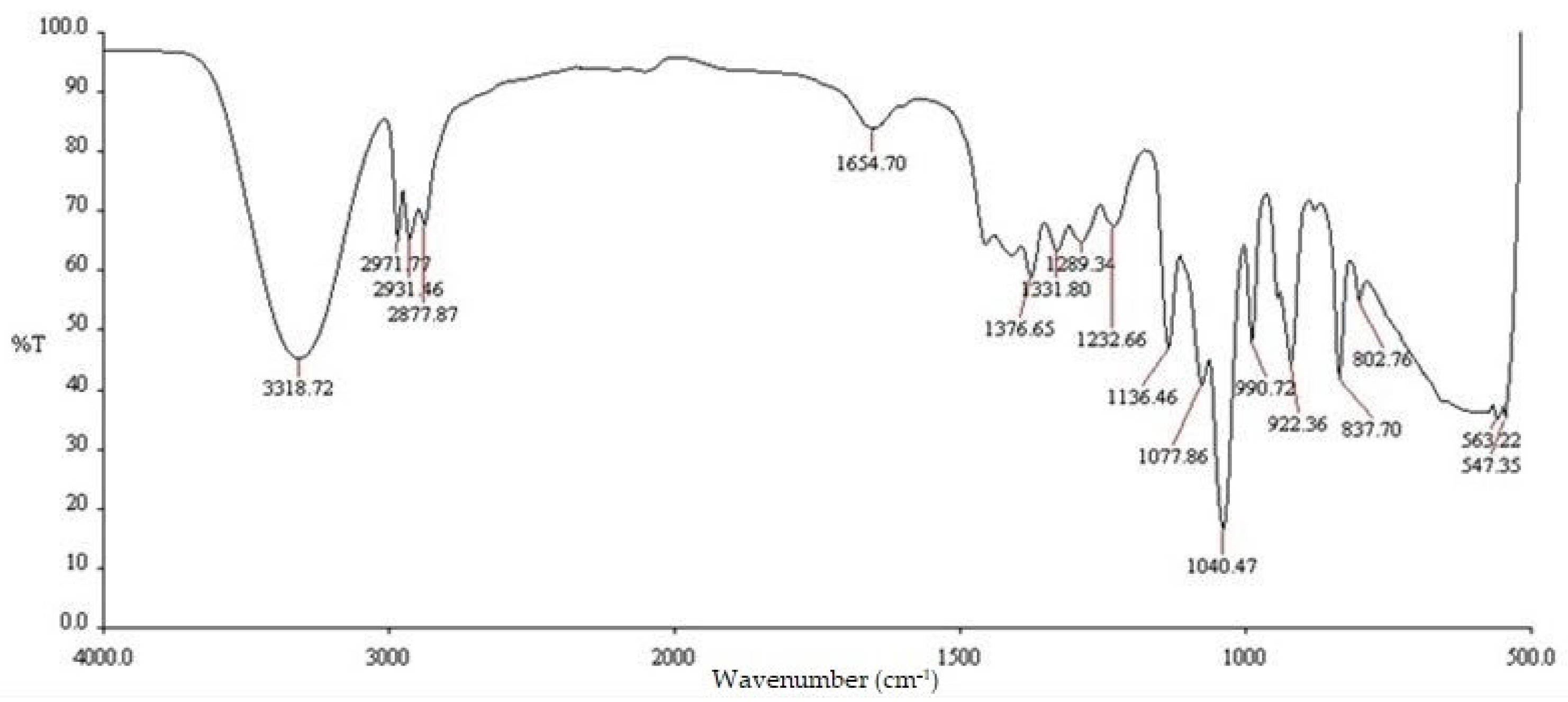
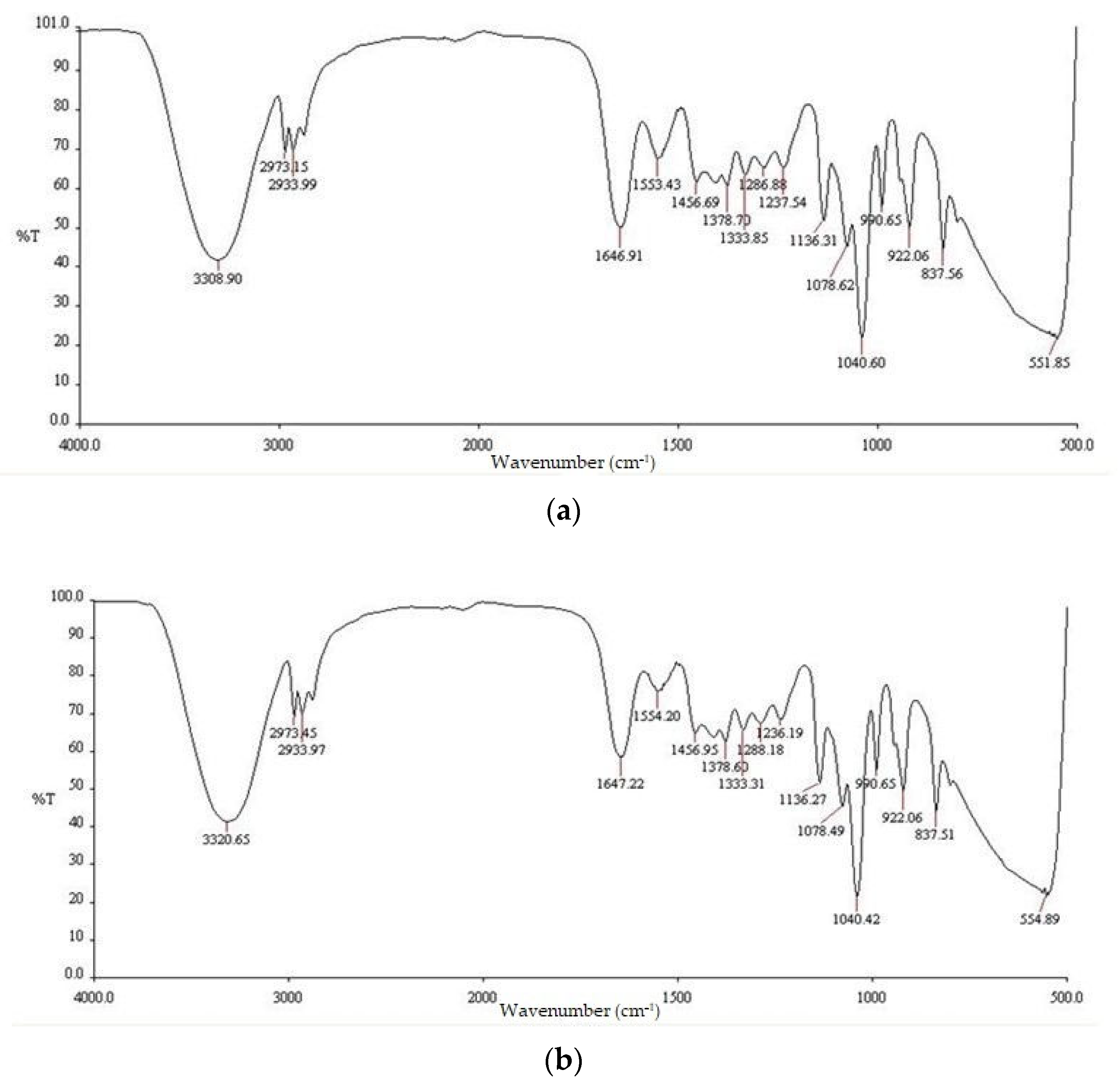
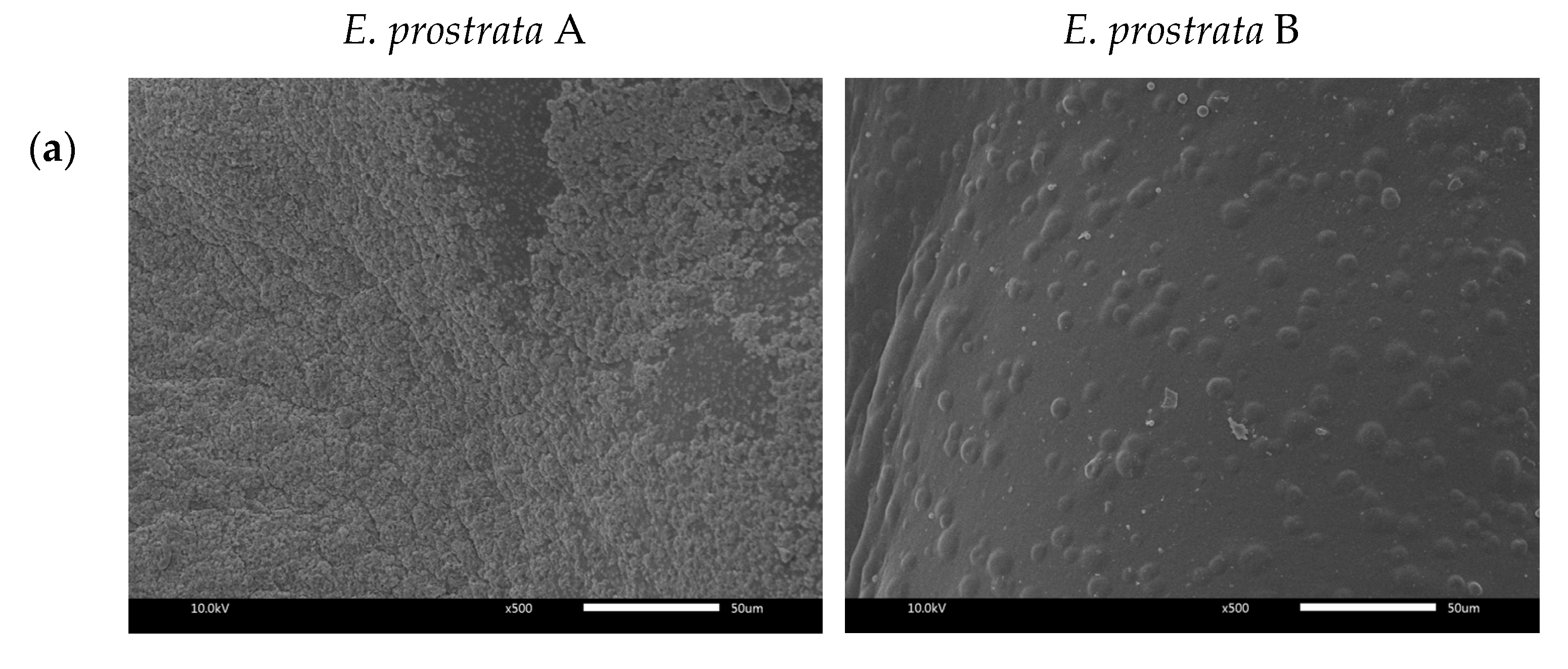
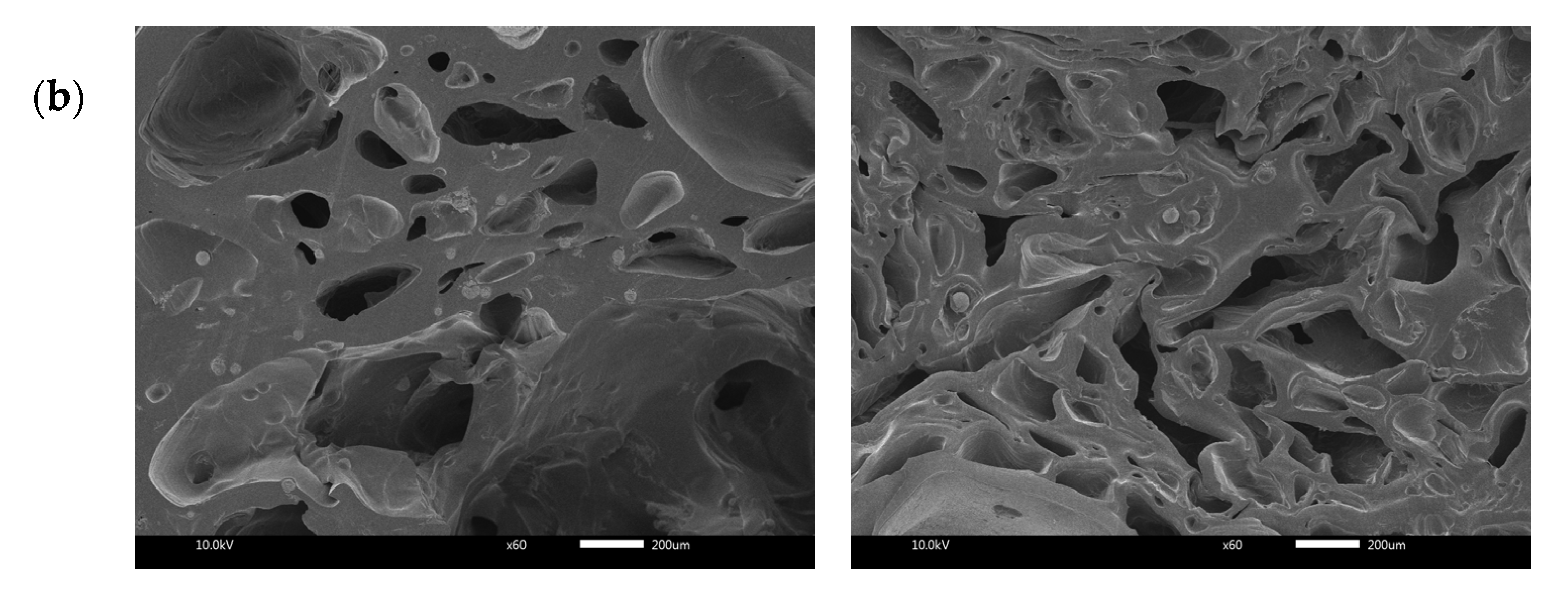
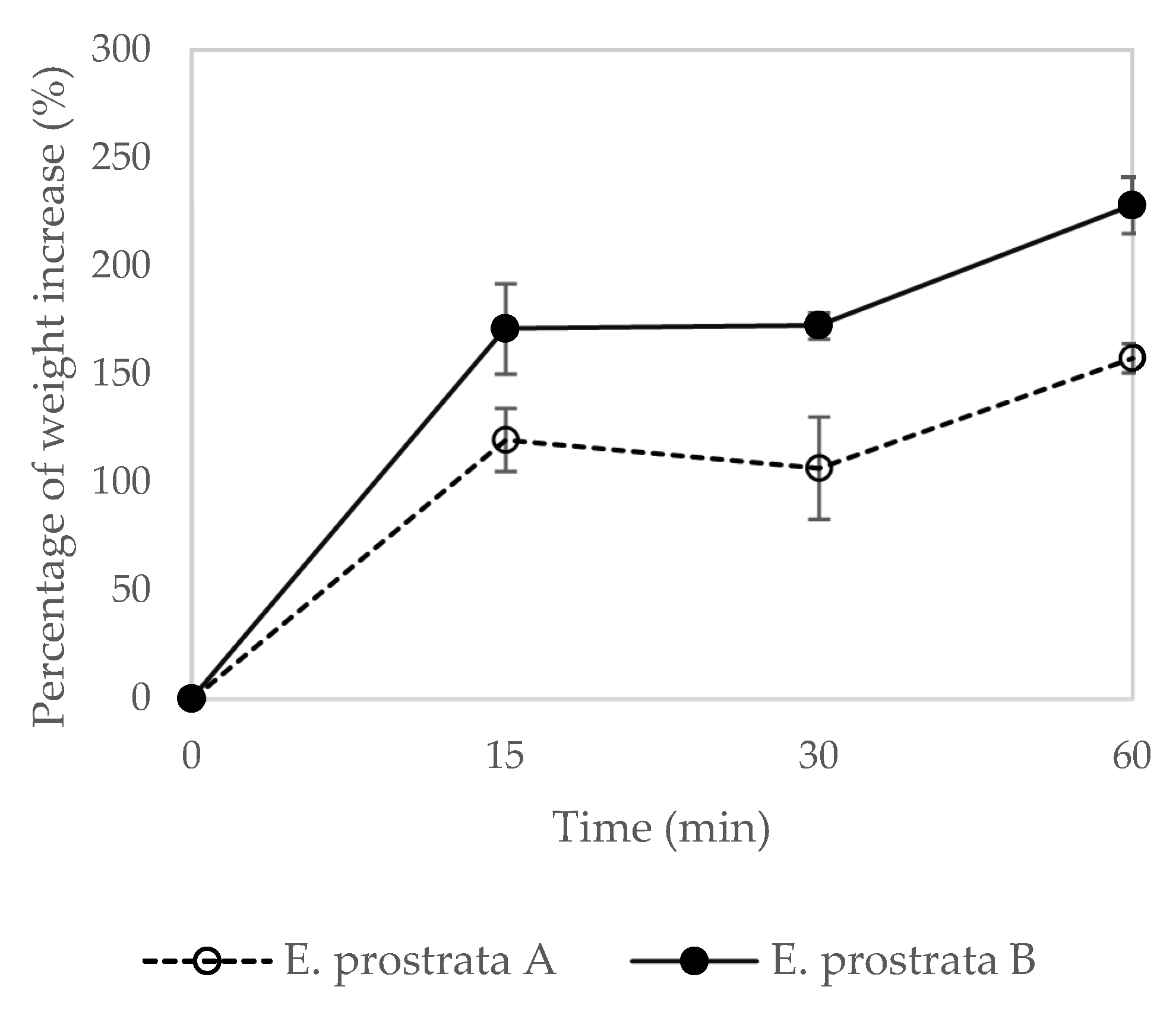
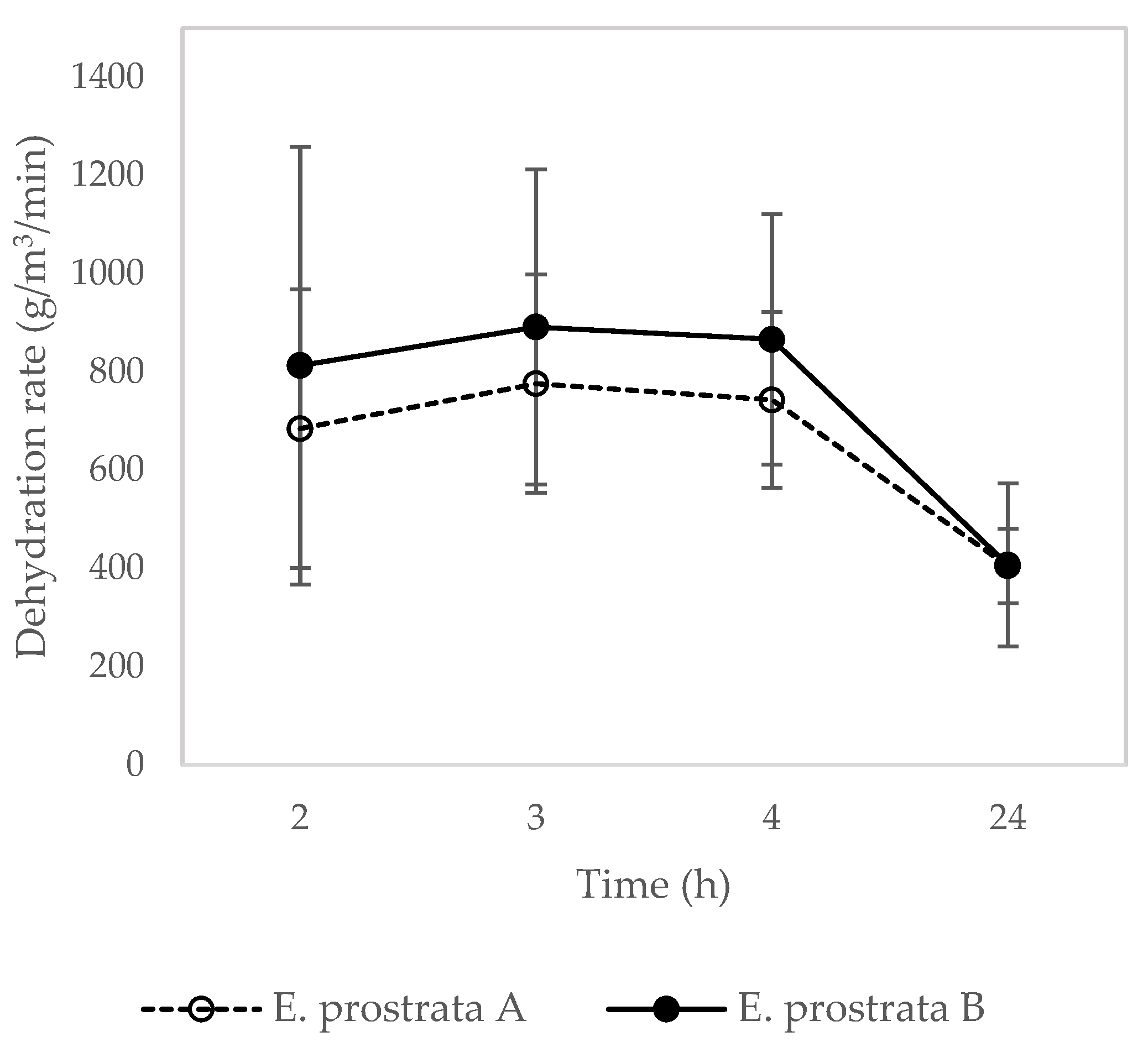
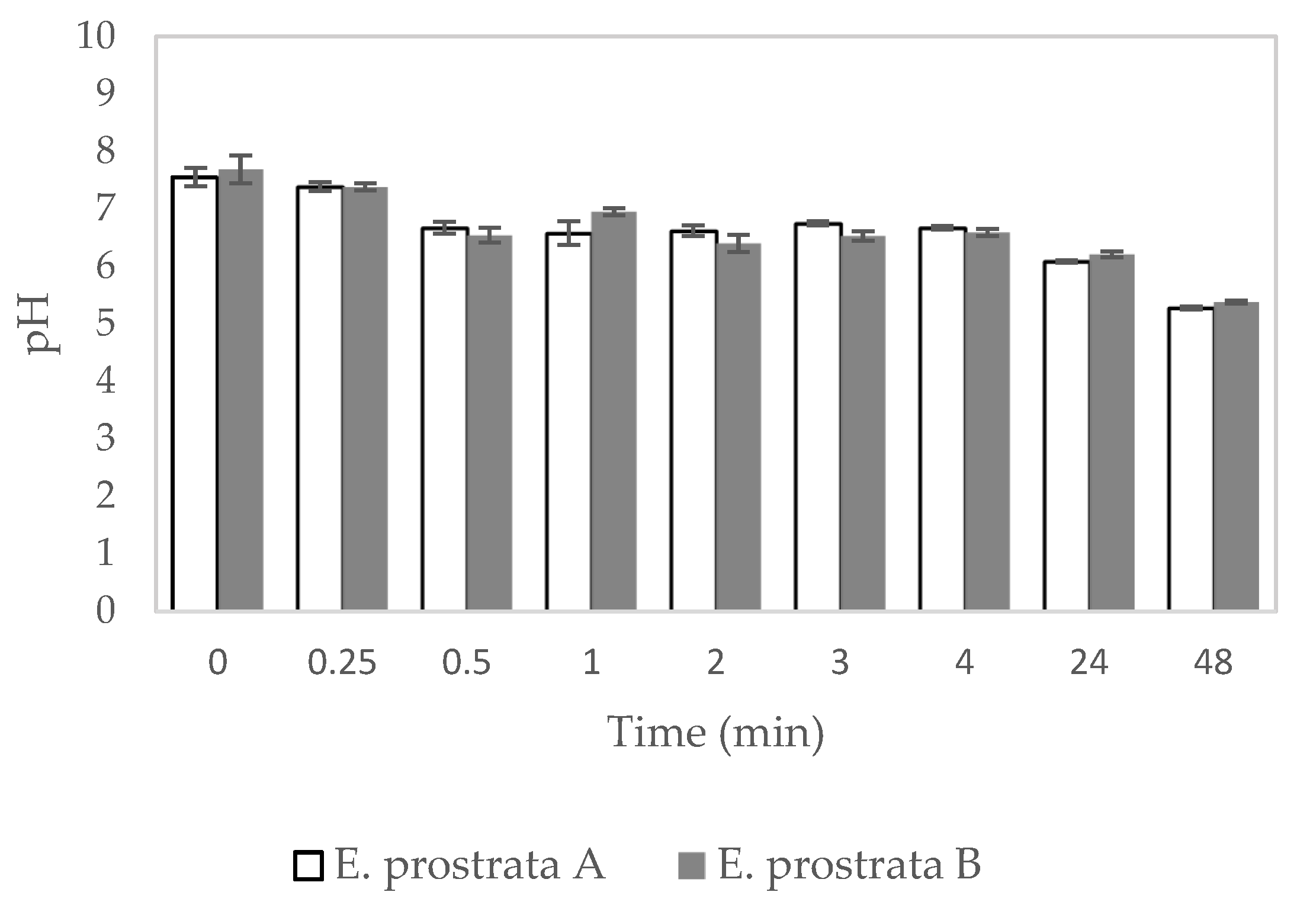
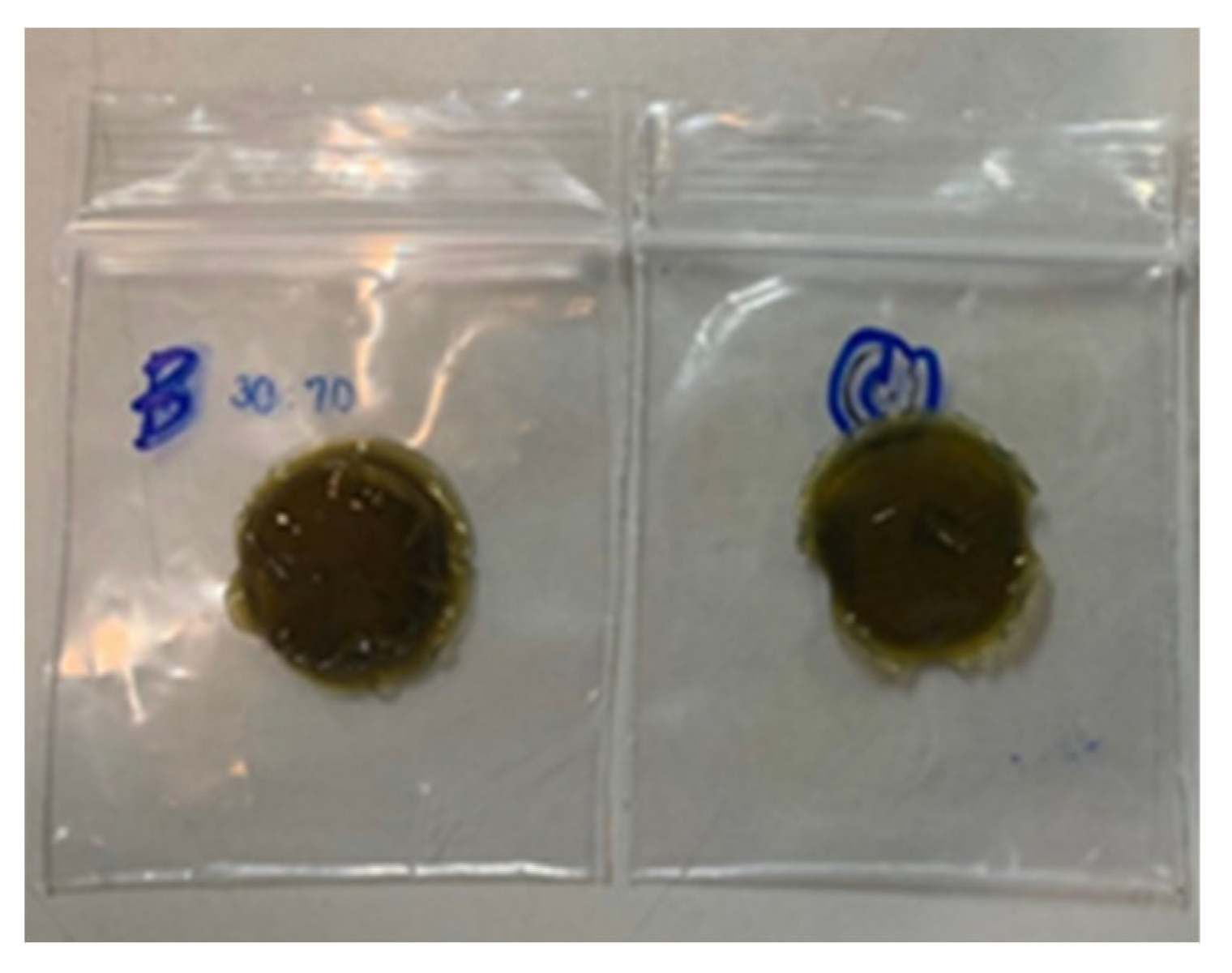
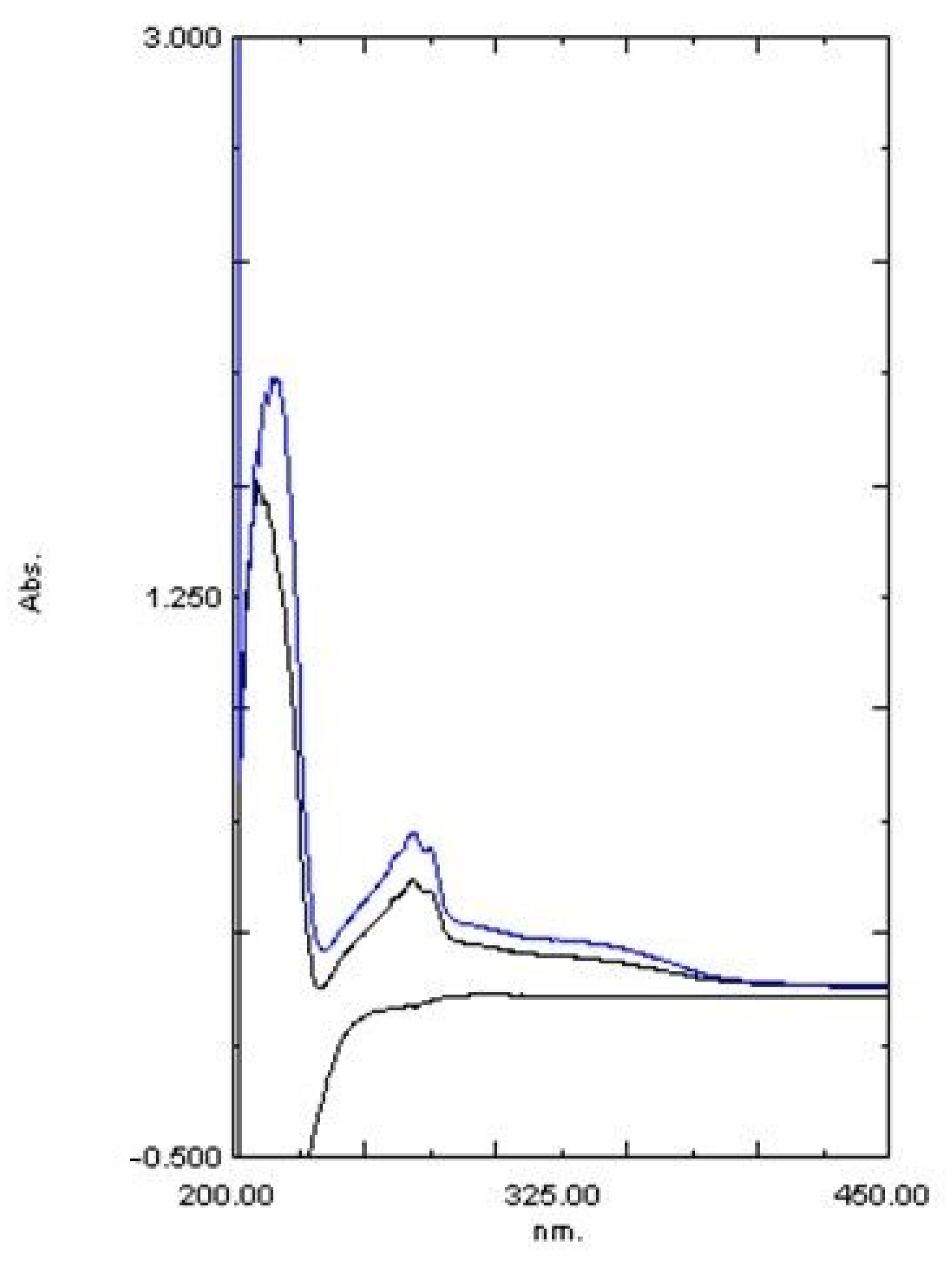
| Functional Groups | Peak Values | ||
|---|---|---|---|
| E. prostrata Leaf Extract | E. prostrata A Dressings | E. prostrata B Dressings | |
| Alkane | 1376.65 2877.87 2931.46 2971.77 | 1378.70 2933.99 2973.15 | 1378.60 2933.97 2973.45 |
| Alkene | 1654.70 | 1646.91 | 1647.22 |
| Halo compound | 802.76 837.70 | 837.56 | 837.51 |
| E. prostrata | E. prostrata Leaf Extract: Gelatin (v/v) |
|---|---|
| A | 3:7 |
| B | 2:3 |
Disclaimer/Publisher’s Note: The statements, opinions and data contained in all publications are solely those of the individual author(s) and contributor(s) and not of MDPI and/or the editor(s). MDPI and/or the editor(s) disclaim responsibility for any injury to people or property resulting from any ideas, methods, instructions or products referred to in the content. |
© 2023 by the authors. Licensee MDPI, Basel, Switzerland. This article is an open access article distributed under the terms and conditions of the Creative Commons Attribution (CC BY) license (https://creativecommons.org/licenses/by/4.0/).
Share and Cite
Hasatsri, S.; Suthi, J.; Siriwut, N.; Charoensappakit, O. Physical Properties and pH Environment of Foam Dressing Containing Eclipta prostrata Leaf Extract and Gelatin. Pharmaceuticals 2023, 16, 685. https://doi.org/10.3390/ph16050685
Hasatsri S, Suthi J, Siriwut N, Charoensappakit O. Physical Properties and pH Environment of Foam Dressing Containing Eclipta prostrata Leaf Extract and Gelatin. Pharmaceuticals. 2023; 16(5):685. https://doi.org/10.3390/ph16050685
Chicago/Turabian StyleHasatsri, Sukhontha, Jariya Suthi, Nattaporn Siriwut, and Onjira Charoensappakit. 2023. "Physical Properties and pH Environment of Foam Dressing Containing Eclipta prostrata Leaf Extract and Gelatin" Pharmaceuticals 16, no. 5: 685. https://doi.org/10.3390/ph16050685
APA StyleHasatsri, S., Suthi, J., Siriwut, N., & Charoensappakit, O. (2023). Physical Properties and pH Environment of Foam Dressing Containing Eclipta prostrata Leaf Extract and Gelatin. Pharmaceuticals, 16(5), 685. https://doi.org/10.3390/ph16050685








